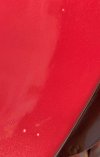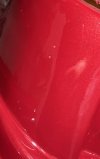milanomaroon
Promoted Users
I just finished painting my jambs and door edges. Used Wandabase and Euroclear over 1:1:1: epoxy sealer (gray). Just to back up a bit, I am a novice at this. I have used epoxy primer before and sprayed some base and clear but it's been awhile.
So after 2 coats of base yesterday I sprayed two coats of clear this morning. After the first coat of clear I noticed several spots (maybe little divots lighter in color than my base) in a couple of areas. What's puzzling I hadn't seen them before I sprayed the clear. Since a couple are on the door bottom and the others are on the lower jamb I'm going to live with it. But I would like to determine why before I spray the main body of the car.
Only thing I might add, I didn't activate the base. I wanted to but just forgot. Everything else seemed to be OK. Sanded cured epoxy with 180g, sprayed 2 new coats of epoxy 2 days ago, sprayed epoxy sealer and two coats of base, then clear. Used SPI water based wax and grease remover.
So after 2 coats of base yesterday I sprayed two coats of clear this morning. After the first coat of clear I noticed several spots (maybe little divots lighter in color than my base) in a couple of areas. What's puzzling I hadn't seen them before I sprayed the clear. Since a couple are on the door bottom and the others are on the lower jamb I'm going to live with it. But I would like to determine why before I spray the main body of the car.
Only thing I might add, I didn't activate the base. I wanted to but just forgot. Everything else seemed to be OK. Sanded cured epoxy with 180g, sprayed 2 new coats of epoxy 2 days ago, sprayed epoxy sealer and two coats of base, then clear. Used SPI water based wax and grease remover.




